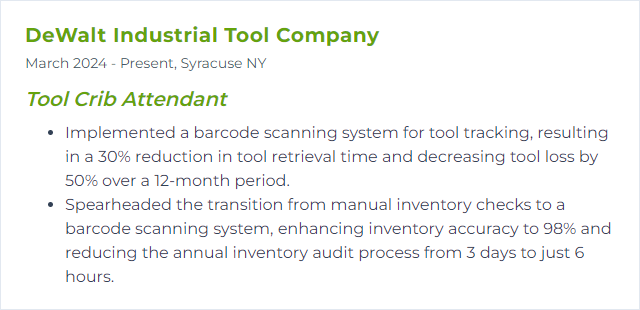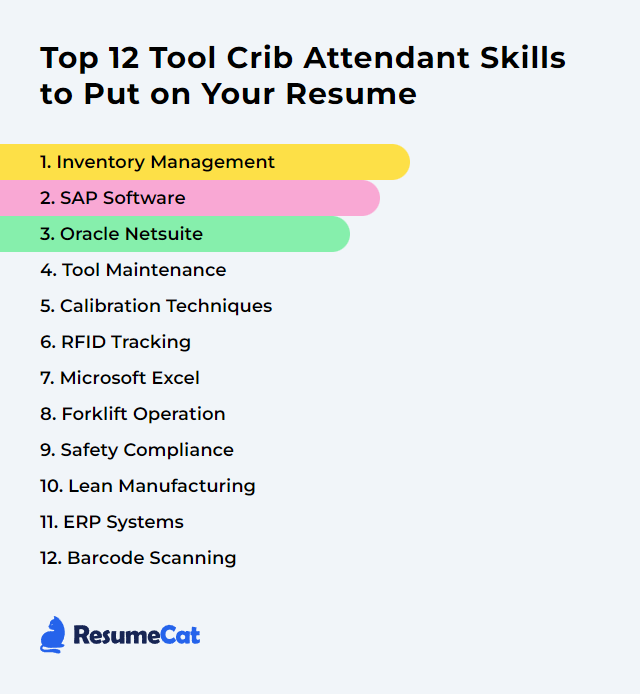Top 12 Tool Crib Attendant Skills to Put on Your Resume
In the competitive landscape of maintenance and manufacturing industries, a well-crafted resume highlighting essential skills is crucial for tool crib attendants aiming to stand out. This article outlines the top 12 skills that candidates should showcase on their resumes to demonstrate their proficiency in managing tools, ensuring operational efficiency, and supporting the needs of their team.
Tool Crib Attendant Skills
- Inventory Management
- SAP Software
- Oracle NetSuite
- Tool Maintenance
- Calibration Techniques
- RFID Tracking
- Microsoft Excel
- Forklift Operation
- Safety Compliance
- Lean Manufacturing
- ERP Systems
- Barcode Scanning
1. Inventory Management
Inventory management, in the context of a Tool Crib Attendant, involves overseeing and controlling the ordering, storage, and distribution of tools and equipment to ensure they are available as needed, while minimizing costs and maintaining optimal stock levels.
Why It's Important
Inventory management is crucial for a Tool Crib Attendant because it ensures the right tools are available when needed, minimizes downtime, controls costs by avoiding overstock or shortages, and maintains accurate records for tracking and accountability.
How to Improve Inventory Management Skills
Improving inventory management, especially for a Tool Crib Attendant, involves a few concise steps:
Implement inventory software: Use a dedicated system to track check-outs/returns, set min/max levels, and see real-time balances. Examples include Sortly, ToolHound, or similar platforms.
Run cycle counts: Schedule frequent cycle counts and periodic full audits to catch discrepancies early and keep records tight.
Organize the crib: Apply 5S. Clear labels, bin locations, shadow boards, and visual cues make retrieval fast and returns consistent.
Standardize check-in/out: Create simple SOPs, train users, and require accountability for damaged or missing tools.
Vendor management: Track lead times, negotiate terms, consider consignment, and align reorder points with supplier performance.
Lean techniques: Use ABC analysis, set reorder points with safety stock, and avoid dead inventory with regular usage reviews.
Data-driven planning: Analyze picks, usage by shift/job, and seasonality. BI dashboards (e.g., Power BI, Tableau) help spotlight trends.
Security controls: Badge access, cameras where appropriate, serialized tags, and exception reports deter loss and shrinkage.
By focusing on these areas, a Tool Crib Attendant can significantly improve inventory management, ensuring tools are available when needed, reducing losses, and maintaining an efficient workflow.
How to Display Inventory Management Skills on Your Resume
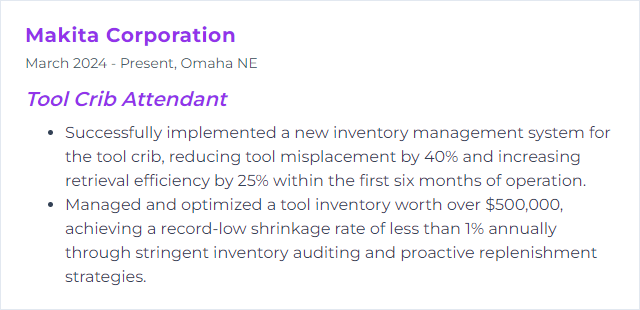
2. SAP Software
SAP software is an enterprise resource planning (ERP) system that helps organizations manage business operations, including inventory and supply chain management, crucial for a Tool Crib Attendant to efficiently track and manage tools and equipment.
Why It's Important
SAP software is important for a Tool Crib Attendant because it streamlines inventory management, tool tracking, and maintenance scheduling, ensuring efficient operation and cost savings.
How to Improve SAP Software Skills
Improving SAP software skills for tool crib work means sharpening processes inside MM, PM, and related modules:
Automate replenishment: Configure reorder points, MRP parameters, and reservations to cut manual steps and prevent stockouts.
Integrate tool tracking: Use SAP Asset Manager or Plant Maintenance to manage tool masters, calibration dates, and maintenance plans.
Tailor reports and apps: Build Fiori tiles and role-based dashboards. Use Crystal Reports or built-in analytics for usage and cost visibility.
Clean master data: Standardize material descriptions, units of measure, and valuation classes. Good data makes everything else smooth.
Go mobile: Enable Fiori/mobile transactions for issue/return, counts, and approvals right on the floor.
Train with intent: Short, scenario-based training for attendants and requesters beats generic, one-size-fits-all sessions.
How to Display SAP Software Skills on Your Resume
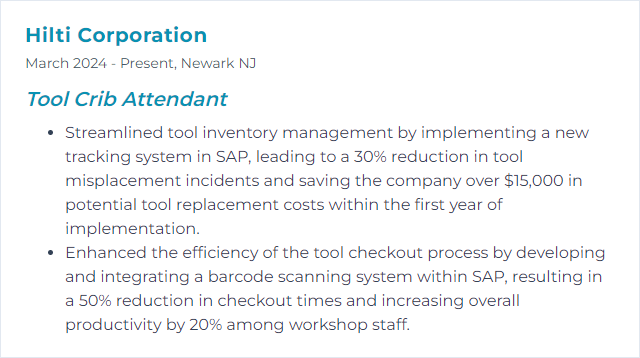
3. Oracle NetSuite
Oracle NetSuite is a cloud-based enterprise resource planning (ERP) suite that integrates business functions, including inventory management. For a Tool Crib Attendant, it helps track tools, manage stock levels, and automate reorders.
Why It's Important
Oracle NetSuite is important for a Tool Crib Attendant as it automates and streamlines inventory management, enabling efficient tracking, management, and replenishment of tools and equipment, ensuring availability and reducing downtime.
How to Improve Oracle NetSuite Skills
Make NetSuite work harder for the crib by dialing in configuration and workflows:
Customize dashboards: Surface KPIs, low-stock alerts, overdue returns, and calibration due dates at a glance.
Enable barcode/mobile: Use barcode scanning and the mobile app for quick issue/return, counts, and transfers.
Automate replenishment: Set reorder points, preferred vendors, and approval workflows to keep shelves ready without overstock.
Use saved searches/analytics: Track usage by job, tool turn rates, and loss trends. Turn insights into stocking rules.
Integrate where needed: Connect smart cabinets, RFID, or specialized tool systems through SuiteTalk or approved connectors.
Tighten roles and permissions: Role-based access and auditable workflows reduce errors and improve accountability.
How to Display Oracle NetSuite Skills on Your Resume
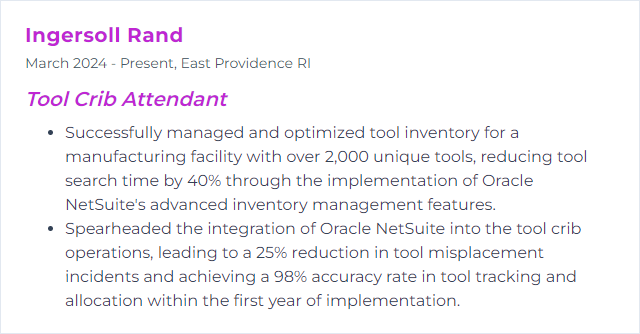
4. Tool Maintenance
Tool maintenance, in the context of a Tool Crib Attendant, involves the systematic inspection, cleaning, repairing, and organizing of tools to ensure they are in good working condition and readily available for use.
Why It's Important
Tool maintenance is essential for ensuring the safety, reliability, and longevity of tools, leading to improved efficiency, reduced downtime, and cost savings in operations. It ensures tools are ready and in optimal condition for use, supporting a smooth workflow and high-quality work outcomes.
How to Improve Tool Maintenance Skills
Boost tool longevity and uptime with disciplined routines:
Organize and schedule: Use a CMMS or inventory system to track usage, assign next service dates, and flag overdue items.
Routine inspections: Quick checklists at return and periodic deep inspections catch damage before it causes a failure.
Clean after use: Follow manufacturer guidance for cleaning, lubrication, and storage. Small habits prevent big repairs.
Repair fast: Stock critical spares, define repair partners, and quarantine unsafe tools immediately.
Train users: Short refreshers on proper use, care, and reporting standards cut misuse and extend tool life.
Calibrate precision tools: Keep a calibration calendar and apply “do not use” tags when out of tolerance.
How to Display Tool Maintenance Skills on Your Resume
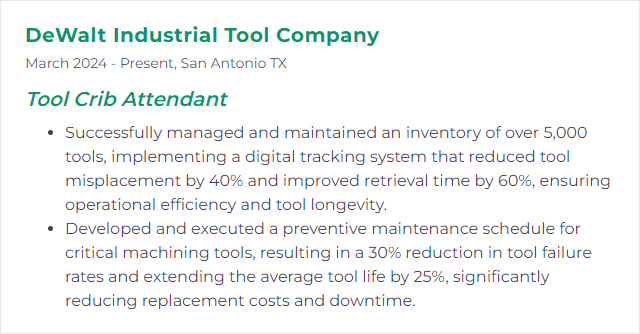
5. Calibration Techniques
Calibration techniques involve verifying and adjusting the accuracy of measurement tools and equipment so they conform to standards. In a tool crib, this means checking instruments against certified references, documenting results, and adjusting or removing tools that fall outside acceptable tolerance.
Why It's Important
Calibration techniques are important for a Tool Crib Attendant because they ensure the accuracy and reliability of tools and equipment, maintaining quality control and safety in operations.
How to Improve Calibration Techniques Skills
Make accuracy repeatable and traceable:
Standardize SOPs: Write step-by-step procedures per tool type, aligned with recognized practices (e.g., ISO/IEC 17025 principles).
Maintain traceability: Use standards and references traceable to national metrology institutes (e.g., NIST) and keep certificates current.
Use certified equipment: Verify calibration gear is within its own calibration window and suitable for the range/accuracy required.
Train and assess: Provide regular training and proficiency checks to reduce technique-driven variation.
Record everything: Log dates, conditions, results, and corrective actions. Label tools with calibration status and due date.
Control the environment: Stabilize temperature and humidity where precision tools are checked and stored.
How to Display Calibration Techniques Skills on Your Resume
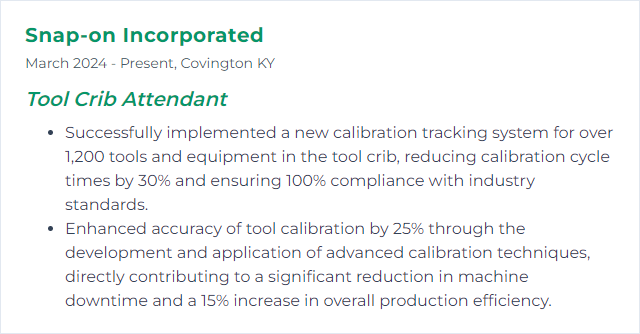
6. RFID Tracking
RFID tracking involves using radio-frequency identification technology to automatically identify and track tools and equipment in a tool crib, enhancing inventory management and reducing loss or misplacement.
Why It's Important
RFID tracking is crucial for a Tool Crib Attendant as it enables efficient, real-time inventory management, reduces tool misplacement or loss, and enhances the accuracy of tool issuance and return processes.
How to Improve RFID Tracking Skills
Turn RFID into a silent, always-on helper:
Choose the right tags: Use UHF for range, HF/NFC for close reads, and on-metal tags where reflection is an issue. Test before rolling out.
Create read points: Gate readers at entry/exit, handhelds for spot checks, and portals near high-traffic areas capture movement without extra steps.
Smart storage: RFID-enabled cabinets or drawers monitor issue/return in real time for critical tools.
Integrate with inventory: Feed reads into your system to update status, trigger reorders, and build usage histories.
Train and audit: Teach basic troubleshooting and run periodic read-rate tests to fix blind spots or interference.
How to Display RFID Tracking Skills on Your Resume
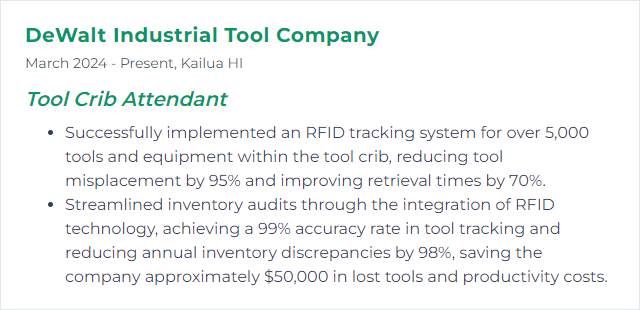
7. Microsoft Excel
Microsoft Excel is a spreadsheet program used for data organization, analysis, and reporting, allowing a Tool Crib Attendant to track inventory, manage tool checkouts, and monitor maintenance schedules efficiently.
Why It's Important
Microsoft Excel is important for a Tool Crib Attendant because it enables efficient tracking, organization, and analysis of tool inventories, maintenance schedules, and usage patterns, ensuring optimal inventory management and operational efficiency.
How to Improve Microsoft Excel Skills
Make spreadsheets work like a lightweight inventory system:
Master key functions: XLOOKUP or INDEX/MATCH, SUMIFS, COUNTIFS, IFERROR—build reliable, flexible sheets.
Data validation: Limit entries to valid options for item IDs, locations, and status to prevent messy data.
Conditional formatting: Flag low stock, overdue returns, and expired calibration at a glance.
PivotTables and charts: Summarize usage by shift/job/tool type and visualize trends instantly.
Power Query: Clean and combine data from multiple tabs or exports without manual copy-paste.
Macros (VBA): Automate recurring tasks—issue logs, replenishment lists, weekly reports.
Structured tables: Convert ranges to Tables for safer formulas and easier filters/slicers.
How to Display Microsoft Excel Skills on Your Resume
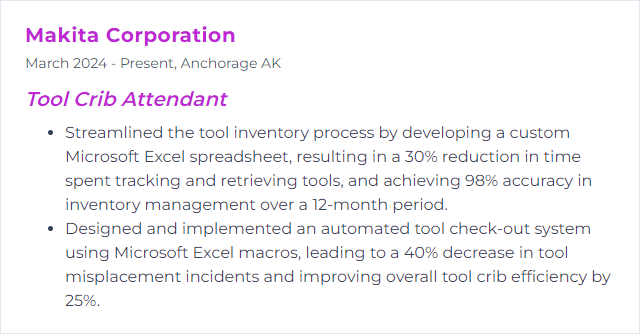
8. Forklift Operation
Forklift operation, in the context of a Tool Crib Attendant, involves the use of a powered industrial truck to lift, move, and position materials and tools within a warehouse or job site, ensuring efficient and safe handling of resources.
Why It's Important
Forklift operation is important for a Tool Crib Attendant because it enables the efficient and safe handling of heavy or bulky tools and materials, facilitating proper inventory management and ensuring timely availability of tools for operational needs.
How to Improve Forklift Operation Skills
Safety first, then speed:
Training and certification: Complete initial and regular refresher training per local regulations and site policies.
Pre-shift inspections: Tires, forks, hydraulics, horn, lights, brakes—log it, fix issues before use.
Smart layout: Mark aisles, set speed limits, zone staging areas, and minimize travel distances to the crib.
Maintenance cadence: Preventive maintenance based on hours and environment keeps trucks reliable and safe.
Technology assists: Pair picks with barcode/RFID to cut errors and tighten traceability.
Ergonomics: Adjust seats, mirrors, and controls for the operator. Comfort improves focus and reduces fatigue.
How to Display Forklift Operation Skills on Your Resume
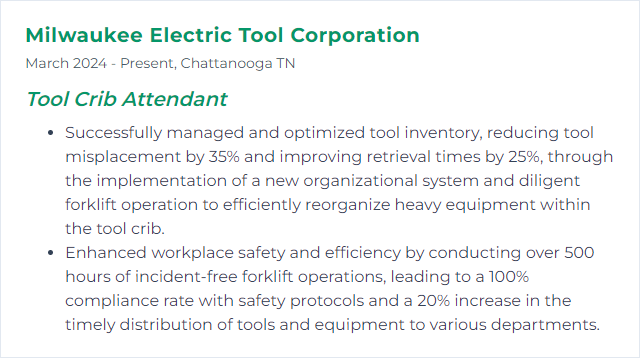
9. Safety Compliance
Safety compliance, in the context of a Tool Crib Attendant, involves adhering to established safety standards and regulations related to the management, maintenance, and distribution of tools and equipment to prevent accidents, injuries, and ensure a safe working environment.
Why It's Important
Safety compliance is crucial for a Tool Crib Attendant to ensure the safe handling and storage of tools, prevent accidents, and comply with legal and workplace safety regulations, thereby protecting both personnel and assets.
How to Improve Safety Compliance Skills
Build a culture that refuses shortcuts:
Regular training: Cover tool handling, PPE, hazard communication, and emergency procedures. Refresh often.
Safety audits: Inspect storage, guards, cords, and walkways. Fix hazards quickly and document corrective actions.
Inspection and maintenance: Keep a documented schedule for tools, ladders, lifting gear, and powered equipment.
Clear signage: Post handling instructions, weight limits, and restricted-area notices where decisions happen.
Emergency readiness: Stock first-aid supplies, maintain extinguishers, and practice drills with posted maps.
Report and learn: Encourage near-miss and incident reporting; close the loop with visible improvements.
SDS and storage: Maintain Safety Data Sheets for chemicals and store materials by compatibility.
How to Display Safety Compliance Skills on Your Resume

10. Lean Manufacturing
Lean Manufacturing is a systematic approach aimed at minimizing waste without sacrificing productivity. For a Tool Crib Attendant, it means efficiently managing and distributing tools and resources to reduce downtime and enhance workflow on the production floor.
Why It's Important
Lean Manufacturing is important for a Tool Crib Attendant because it ensures the efficient use of tools and materials, reduces waste, and improves workflow, leading to increased productivity and cost savings.
How to Improve Lean Manufacturing Skills
Tighten the flow, shrink the waste:
JIT with Kanban: Use cards or digital signals to replenish only what’s needed, when it’s needed.
5S everywhere: Sort, set in order, shine, standardize, sustain. The crib becomes a fast, frictionless stop.
TPM mindset: Blend maintenance into the rhythm of work so failures rarely surprise you.
Visual management: Boards, lights, and color codes make status and priorities obvious at a glance.
Value stream mapping: Trace the path tools take from request to return and remove bottlenecks.
Kaizen culture: Encourage frequent, small improvements from those who touch the process daily.
How to Display Lean Manufacturing Skills on Your Resume
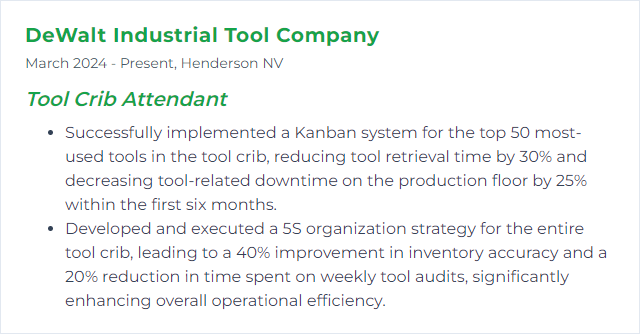
11. ERP Systems
ERP (Enterprise Resource Planning) systems are integrated software platforms that manage and automate core business processes, including inventory management. For a Tool Crib Attendant, an ERP system streamlines tracking, distribution, and maintenance of tools and equipment, ensuring efficient operations and accurate records.
Why It's Important
ERP systems are crucial for a Tool Crib Attendant because they streamline inventory management, ensure accurate tracking of tools and materials, reduce the risk of stockouts or excess inventory, and improve the efficiency of issuing and returning items, ultimately enhancing productivity and cost control.
How to Improve ERP Systems Skills
Turn the ERP into a real-time source of truth:
Automate tool tracking: Pair the ERP with barcode or RFID for quick issue/return and clean audit trails.
Connect condition data: Integrate IoT sensors where relevant to trigger maintenance before failures.
Optimize inventory policy: Use ABC classification, forecasting, and safety stock rules that match demand volatility.
Role-based screens: Simplify transactions for attendants with tailored forms and shortcuts.
Real-time alerts: Set notifications for low stock, overdue returns, and calibration due dates.
Training and job aids: Provide quick-reference guides and short videos tied to the exact tasks performed.
Custom reporting: Build reports for usage, costs, and losses; review them in regular huddles.
Govern master data: Clean material masters, standardize naming, and de-duplicate to boost accuracy.
How to Display ERP Systems Skills on Your Resume
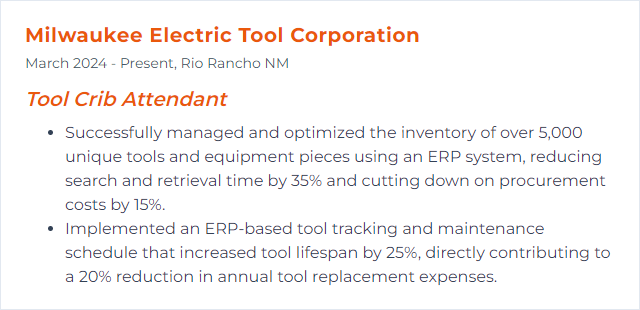
12. Barcode Scanning
Barcode scanning in the context of a Tool Crib Attendant involves using a scanner to read barcodes on tools and equipment for tracking, inventory management, and issuing or returning items efficiently.
Why It's Important
Barcode scanning is important for a Tool Crib Attendant because it ensures accurate tracking and management of tools and equipment, streamlines inventory control, and enhances efficiency by reducing manual data entry errors.
How to Improve Barcode Scanning Skills
Faster scans, fewer errors:
Pick the right hardware: Choose rugged scanners with long battery life that read damaged or dirty labels when needed.
Make better labels: Use durable stock, proper contrast, and place labels where they won’t get scuffed. Follow clear, consistent symbology (e.g., Code 128).
Go mobile: Tablets or phones with quality scanning software add flexibility at bins, benches, and docks.
Train technique: Angle, distance, and pacing matter. Short practice kills most misreads.
Integrate tightly: Ensure scans update your inventory system in real time and trigger workflows (reorders, holds, maintenance).
Maintain and update: Clean optics, update firmware, and replace worn batteries to keep performance sharp.
How to Display Barcode Scanning Skills on Your Resume
